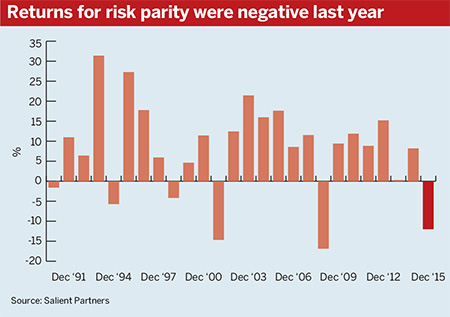Analysis: Risk parity funds promise diversification and consistent performance through risk allocation, but in the current climate of interest rate uncertainty how suitable is this strategy for pension schemes?
Clouds have gathered over risk parity’s 'all-weather' approach over the past year, with poor performance affecting its reputation for being able to tolerate market volatility. Things have brightened up more recently, but experts are still concerned about this choice of strategy for pension schemes.
The approach, which continues to be more popular across the pond than among UK pension funds, involves having an equally weighted portfolio that avoids concentration of risk.
If equities look risky, you reduce your equity content and you switch into bonds, as being somewhere safe. What do you do if bonds are the risk?
Clive Gilchrist, Bestrustees
A traditional portfolio will invest around 60 per cent in equities and 40 per cent in bonds, whereas a risk parity portfolio limits the asset allocation to two or three different asset classes, usually equities, bonds and commodities, and attempts to spread risk evenly across them.
Nowhere else to go
Mark Hodgson, managing director at Gatemore Capital Management, which in the past has warned against the risk parity approach, said that these sorts of strategies “work when they do, but when they don’t, they can go horrifically wrong”.
He said risk parity funds are model-based and, when building these kinds of models, they almost always work when applied to the recent past. But over time, “the future doesn’t play out the way that history has played out”.

Risk parity relies on the negative correlation of equities and bonds. However, more recently, markets have not moved in the way that these models have predicted, which has affected performance, Hodgson said. “You’re allocating to two or three [asset classes], and when they move together in the wrong direction, you’ve got nowhere else to go.”
Ultimately, “if someone could build a model that worked in every kind of environment, they’d be multi-billionaires and they’d be sitting somewhere else”, he added.
Matthew Kay, Gatemore’s director of risk management, pointed out that when pension funds are presented with good track records in relation to risk parity funds, it is important to put that performance into context.
“Some of these funds haven’t been going for very long, and emerged in the aftermath of the 2008 financial crisis”, he said.
Kay noted that risk parity funds tend to have a higher proportion of fixed income assets, and the ongoing low-yield environment has been an advantage for risk parity funds. But while yield levels are getting close to the lowest they have been in recorded history, “the question is, how much can that continue?”
Clive Gilchrist, deputy chair of independent trustee company Bestrustees, had a similarly negative view of the risk parity approach: “If equities look risky, you reduce your equity content and you switch into bonds, as being somewhere safe. What do you do if bonds are the risk?”
Current low global interest rates mean this “doesn’t look likely in the short term”. But he added that if bonds collapse because interest rates look like they are going to rise, that makes equities expensive as well.
Gilchrist said that risk parity funds restrict the universe of assets they invest in, leaving few choices in times when prices are high. “What do you do if everything is expensive?” he said.
Diversification
Incorporating risk parity can be good for diversification because it gives a scheme a different set of returns, Gilchrist said. However, “my concern is that it’s not something that will necessarily always give you positive returns”, he added.
Simon Cohen, head of investment at pension consultancy Spence & Partners, agreed the idea behind risk parity funds is that they offer a diversified approach in terms of allocating across different risk buckets.
However, Cohen said that there are issues around the way these funds are structured.
The strategy, he said, “assumes that markets move in different directions”, leading to diversification benefits. But he warned that when markets end up becoming correlated, particularly when it happens very quickly, risk parity funds can suffer.














